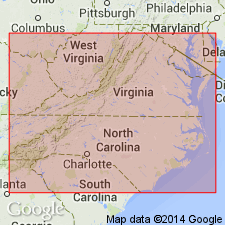
- Usage in publication:
-
- Crossnore plutonic-volcanic group
- Modifications:
-
- First used
- AAPG geologic province:
-
- Piedmont-Blue Ridge province
Summary:
This group is informally named for town of Crossnore, NC, in southwest corner of Winston-Salem quad, near which two small bodies of aegirine-augite granite are exposed. Volcanic rocks of the group include rhyolite and basalt in Mount Rogers and Grandfather Mountain Formations. Metamorphosed basalt in Ashe Formation included tentatively. Plutonic rocks include Beech Granite, Striped Rock Granite, and Bakersville Gabbro in Blue Ridge anticlinorium, and Brown Mountain Granite and Linville Metadiabase in Grandfather Mountain window. Granite and gabbro intrude Elk Park plutonic group of intermediate Precambrian age. Age of Crossnore is younger Precambrian based on dates from rhyolites reported by Rankin and others (1969).
Source: GNU records (USGS DDS-6; Reston GNULEX).
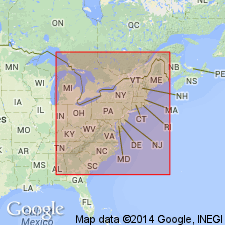
- Usage in publication:
-
- Crossnore Plutonic-Volcanic Complex*
- Modifications:
-
- Named
- Dominant lithology:
-
- Basalt
- Rhyolite
- Granite
- Gabbro
- AAPG geologic province:
-
- Piedmont-Blue Ridge province
Summary:
Crossnore plutonic-volcanic group formally named as Crossnore Plutonic-Volcanic Complex. Includes volcanic rocks of 1) Grandfather Mountain Formation in Grandfather Mountain window, NC, 2) Mount Rogers Formation of southwestern VA, 3) the Catoctin Formation north of Roanoke, VA, and 4) consanguineous intrusive rocks associated with the formations. Age is late Precambrian. [Inclusion of Striped Rock, Beech, and Brown Mountain Granites, Bakersville Gabbro, and Linville Metadiabase is implied, but not clearly spelled out. Inclusion of Catoctin in the Crossnore was probably not intended, per oral communication with first author; however, GNU records reflect its inclusion.]
Source: GNU records (USGS DDS-6; Reston GNULEX).
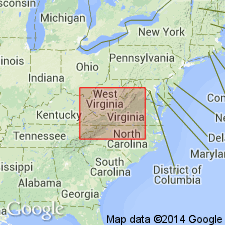
- Usage in publication:
-
- Crossnore Complex
- Modifications:
-
- Revised
- Overview
- AAPG geologic province:
-
- Piedmont-Blue Ridge province
Summary:
Contains a suite of peralkaline granites representing the youngest series of major granitoid intrusions cutting Blue Ridge basement massifs. Larger bodies are Robertson River Pluton and herein named Suck Mountain Pluton, the associated Striped Rock and Cattron Pluton, and Beech Pluton. Among the better mapped and/or better studied smaller plutons are Rockfish River Pluton, Stewartsville Pluton (herein named), and Mobley Mountain Pluton (herein named) in Lovingston Massif; Buckeye Knob Pluton (herein named) in Elk Park Massif; Brown Mountain Pluton in Globe Massif; and Elkin Stock (herein named) in Sauras Massif. Additional plutons are Leander Mountain Pluton (herein named), Crossnore pluton, Rock House pluton, Danbury pluton, and Capella pluton. [Capitalization is identical to authors' usage in report.]
Source: GNU records (USGS DDS-6; Reston GNULEX).
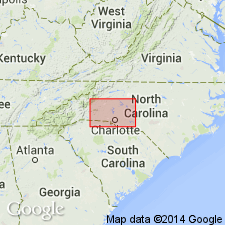
- Usage in publication:
-
- Crossnore Complex*
- Modifications:
-
- Revised
- Age modified
- AAPG geologic province:
-
- Piedmont-Blue Ridge province
Summary:
Crossnore Plutonic-Volcanic Complex revised as Crossnore Complex because Crossnore contains two classes of rocks, sedimentary and igneous (North American Code of Stratigraphic Nomenclature, 1983, art. 37). On map, includes only Brown Mountain Granite and Linville Metadiabase. Authors do not include Grandfather Mountain Formation in Crossnore Complex in map explanation, but note in a footnote that it was included by Rankin and others (1973). [This was probably a mistake; Grandfather Mountain Formation should have been included in Crossnore Complex in this report.] Age is Late Proterozoic.
Source: GNU records (USGS DDS-6; Reston GNULEX).
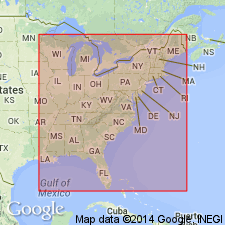
- Usage in publication:
-
- Crossnore Complex*
- Modifications:
-
- Revised
- Areal extent
- AAPG geologic province:
-
- Piedmont-Blue Ridge province
Summary:
Rocks similar to Crossnore Complex's felsic and mafic volcanic and plutonic rocks have been identified as far north as western Newfoundland (Williams and others, 1985), but none have been identified south of Grandfather Mountain window area. It is suggested that the name Crossnore be restricted to rocks in vicinity of Mt. Rogers Embayment.
Source: GNU records (USGS DDS-6; Reston GNULEX).
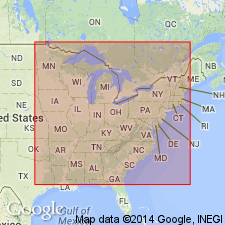
- Usage in publication:
-
- Crossnore Complex*
- Modifications:
-
- Overview
- AAPG geologic province:
-
- Piedmont-Blue Ridge province
Summary:
On the correlation chart for Precambrian rocks of the conterminous United States, the Crossnore Complex of the central and southern Laurentian Appalachians is shown to be of Late Proterozoic age (approximately 800-680 Ma).
Source: GNU records (USGS DDS-6; Reston GNULEX).
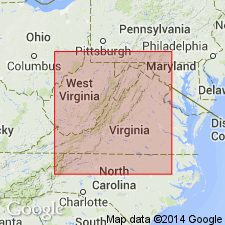
- Usage in publication:
-
- Crossnore Complex
- Modifications:
-
- Age modified
- Geochronologic dating
- AAPG geologic province:
-
- Appalachian basin
- Piedmont-Blue Ridge province
Summary:
Zircon U-Pb geochronology yields the following ages:
759 +/-7 Ma for rhyolite of Mount Rogers Formation;
572 +/-5 Ma for a hypabyssal felsic dike of Catoctin Formation;
564 +/-9 Ma for rhyolite of Catoctin; and
1.1 Ga for detrital zircon in metarhyolite of Catoctin.
Volcanic rocks of Mount Rogers and Catoctin differ in age by about 200 m.y., invalidating previous geochronology that combined U-Pb data to derive an upper intercept age of about 810 Ma (Rankin and others, 1983). Therefore, age of Catoctin is now considered Late Proterozoic and Early Cambrian.
Source: GNU records (USGS DDS-6; Reston GNULEX).
For more information, please contact Nancy Stamm, Geologic Names Committee Secretary.
Asterisk (*) indicates published by U.S. Geological Survey authors.
"No current usage" (†) implies that a name has been abandoned or has fallen into disuse. Former usage and, if known, replacement name given in parentheses ( ).
Slash (/) indicates name conflicts with nomenclatural guidelines (CSN, 1933; ACSN, 1961, 1970; NACSN, 1983, 2005, 2021). May be explained within brackets ([ ]).

